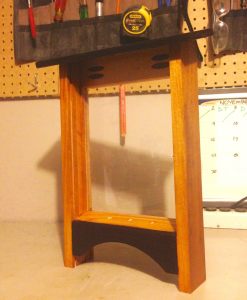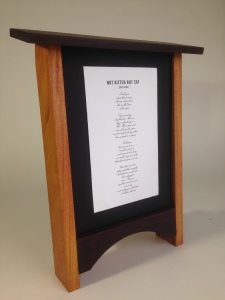In Part 1 of this series, we introduced the poetry box phenomenon, using Portland, Oregon, and St. Tammany Parish, Louisiana, as case studies in how residents can bring poetry boxes to their communities. We also spoke with poet David Cooke about his experiences promoting Portland poetry boxes.
This installment builds upon the first, looking specifically at how educators can establish poetry boxes in their schools. We had the opportunity to ask Ida Galash some questions regarding this process. Galash is the K-8 visual arts educator at The Madeleine School in Portland, and she has worked recently to install a poetry box in her school.

The Madeleine School and Parish Poetry Box under construction. It is made from Mahogany, Western Red Cedar, Black Walnut, and century-old reclaimed Indian Rosewood. Designed and handcrafted by David Cooke and Rich Hogan.
What we find most exciting about Galash’s advice is its focus on cross-curricular participation, with representatives from different departments working together for a common goal. Indeed, we see in Galash’s plan the potential for thematic pairings in everything from literature, art, history, and music.
History students learning about the Civil War, for instance, could work with their peers in American literature classes to display Whitman’s “When the Lilacs Last in the Dooryard Bloom’d” and “The Gettysburg Address.” Art History students could display iconic or evocative images from that era, perhaps a Battle of Gettysburg Lithograph or Winslow Homer’s “Home, Sweet Home.” Chorus students could perform folk songs popular during the Civil War – perhaps “Tenting On the Old Campground,” “Johnny Has Gone For a Soldier,” and “The Dying Soldier,” performed here by the Concordia Choir.
At a time when so many schools are experiencing funding cuts in the arts, establishing such connections is essential, not only for assuring the continued presence of arts/humanities classes but also for helping students make meaningful associations between their coursework in different subjects.
While Galash works specifically with younger students, and thus takes on most of the responsibilities associated with maintaining boxes and selecting poems, educators at the high school and college level can encourage more direct student involvement. Creative writing classes and student organizations could select content and take charge of box upkeep, perhaps incorporating poetry boxes into campus beautification projects. Individual professors can install boxes outside their offices and in building corridors.
As both parts of this series indicate, then, individual residents, teachers, and students have the power to spark community interest in literature and the arts. They can help make such content more accessible and create lasting connections between subject matter. Such involvement brings literature and art outside the confines of individual classes, weaving them into the physical foundations of schools and campuses.
OTB: How did the plan come about to put poetry boxes in your school?
Galash: I had seen poetry boxes in my neighborhood and thought they were a great idea and way to build community. As the art instructor in a K – 8 school, I had been asked to draw up a five-year plan for my art department. One element I felt strongly about including was art that was accessible to the community. A poetry box seemed like a natural way to connect to the community, provide an unusual “canvas” for student art, and make cross-curricular connections into their language arts studies.
OTB: What are the benefits of putting poetry boxes in schools?
Galash: In addition to the community connections, I strongly believe that having their work displayed, visual art or written words, is powerful for the students. It can enhance self-esteem, generate conversations, nurture an interest in or even love of poetry, and encourage kids and adults alike to pause a moment to enjoy a bit of creativity.
OTB: Who will be in charge of maintaining the boxes and selecting poems?
Galash: I will inspect them for any needed maintenance. However, I am fortunate to have selected David of Poetry Boxes to make and install our box; as the artist and craftsman, he wants to make sure the box is in top condition, so he will get a call if there is a problem. After David, our wonderful school maintenance man would be able to help. I will probably select the poems for the box; however, I am hoping to work with the classroom teachers who do poetry with their students.
The day-to-day goings of the box and its contents should be smooth. Once the box is in place, if there is a lull without student work, I can always slip in a poem from another source for inspiration. (David mentioned he is very careful to contact living poets before using their work in a box.)
The box at my school, The Madeleine, in NE Portland Oregon, is being purchased with a gift from my neighbors in memory of my sister, Laurie Cuda, a wonderful person, language arts teacher, and poetry lover, who passed away in March 2014.
OTB: How are other teachers specifically getting involved?
[S]ince the box isn’t in place yet, things are still a bit nebulous. I have mentioned it at faculty meetings and asked them to collect student poetry for the box when they do poetry with their students. I will revisit this again before the Christmas break to build enthusiasm. It is in the early stages at the school level. The big hurdle was getting approval from the committees.
I could get our school staff members involved by sponsoring a staff haiku contest or something as a fun way to raise awareness of the project. As I don’t like to add to the classroom teachers’ very full plates, I will look for ways to incorporate what they are already planning in their lessons but keep them mindful of the opportunity to feature some of the kids’ poems in the box. And poems offer great opportunities for illustration – as I do teach art, I can always weave some poetry into my lesson plans.
OTB: What advice do you have for other educators who’d like to establish poetry boxes in their schools?
Galash: I would encourage them to think through and write down the details before presenting the idea formally, including where the post might be installed, how will it be financed and maintained, what they feel would be the benefits to their particular community, where the poems will come from, and who will print them and fill the box.
One precaution I will take is to not use the students’ full names on [original work] due to privacy and/or security reasons.
We’ll be checking back with Cooke and Galash in the future to see how their plans have progressed.
Interested in putting a poetry box in your school? Let us know, and tell us about what your school is doing to make art accessible and to facilitate cross-curricular connections.

